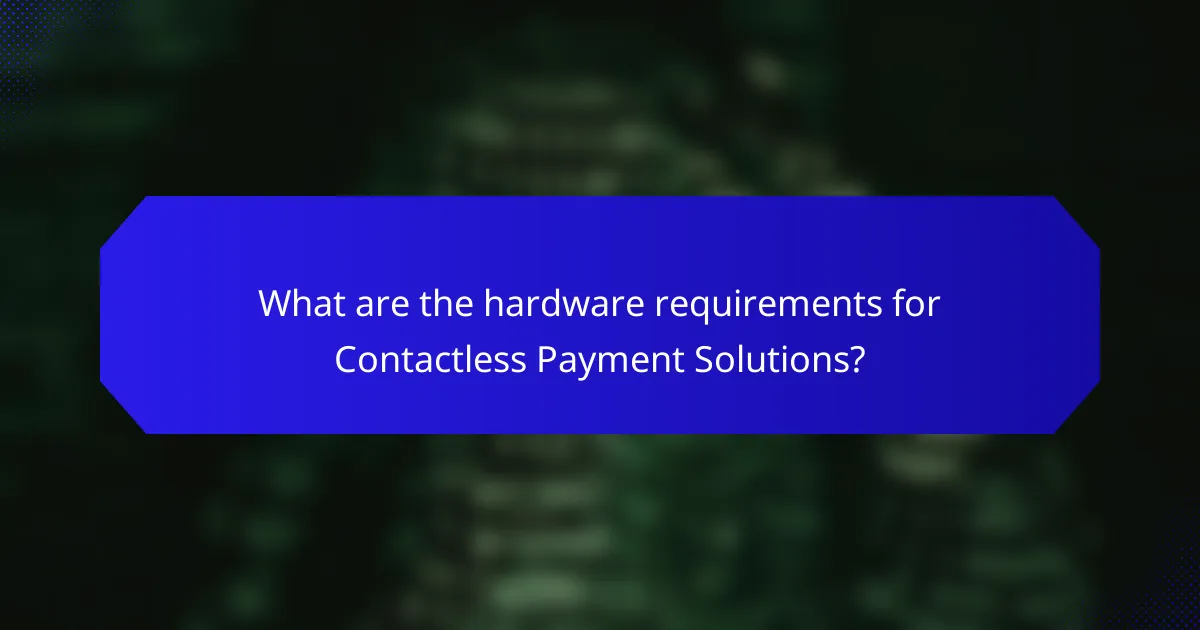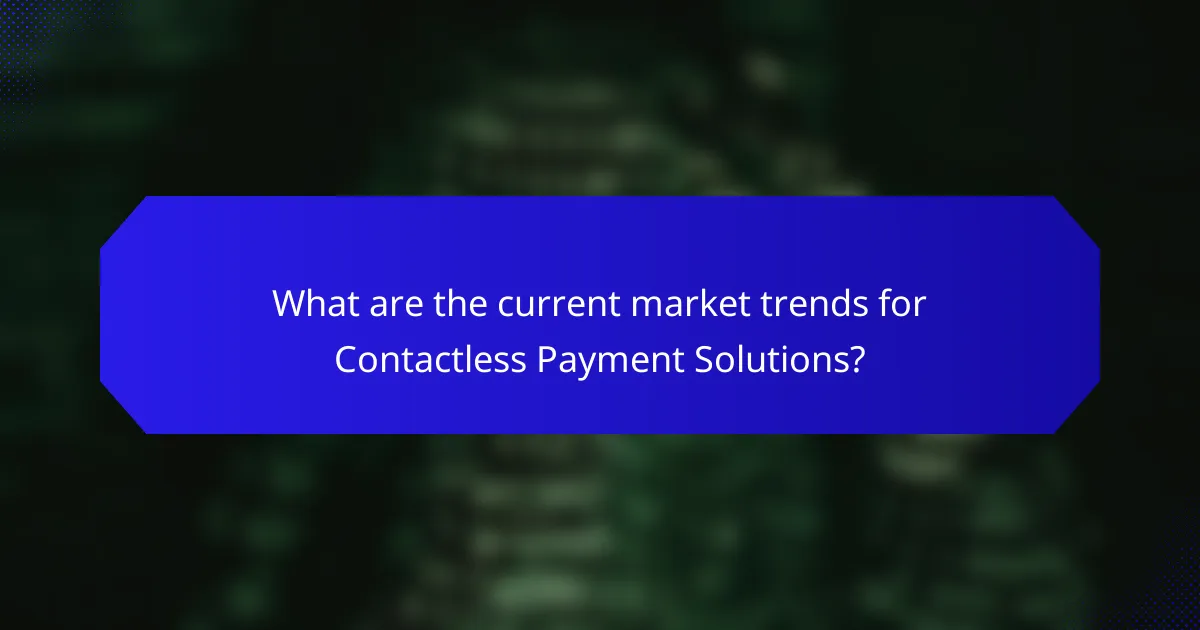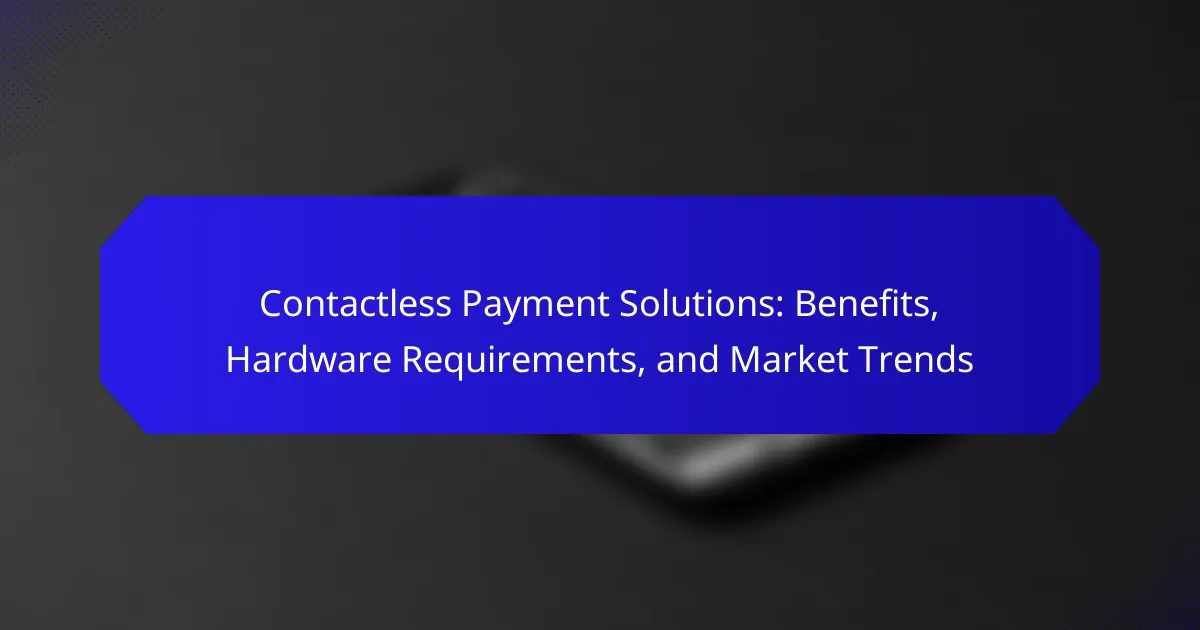Contactless payment solutions enable consumers to conduct transactions without physical contact, primarily utilizing technologies such as Near Field Communication (NFC) and RFID. These methods allow users to quickly make payments by tapping or waving their cards or mobile devices at compatible terminals, enhancing transaction speed and convenience. The article explores the essential hardware components required for effective contactless payment systems, including NFC terminals and secure elements for storing sensitive information. Additionally, it examines current market trends, highlighting significant growth projections and the increasing adoption of contactless payments among consumers and retailers, driven by preferences for efficiency and safety.

What are Contactless Payment Solutions?
Contactless payment solutions are methods of transaction that allow consumers to make payments without physical contact. These solutions typically use technologies such as Near Field Communication (NFC) or RFID. Consumers can simply tap or wave their payment cards or mobile devices near a compatible terminal. This process is quick and efficient, often taking just a few seconds. According to a study by Mastercard, 82% of consumers prefer contactless payments for their speed and convenience. Contactless payments also enhance security by using encryption and tokenization, reducing the risk of fraud.
How do Contactless Payment Solutions function?
Contactless payment solutions function by using radio frequency identification (RFID) or near-field communication (NFC) technology. These technologies enable secure communication between a payment terminal and a payment card or mobile device. When a user taps their card or device near the terminal, the two devices establish a connection. This connection allows for the exchange of payment information.
The payment data is transmitted wirelessly and is encrypted for security. The terminal processes the transaction within seconds. According to a study by the Smart Card Alliance, contactless payments can reduce transaction times by up to 50%. This speed enhances the user experience and increases transaction efficiency for merchants.
What technologies enable Contactless Payment Solutions?
Contactless payment solutions are enabled by technologies such as Near Field Communication (NFC), Radio Frequency Identification (RFID), and mobile wallets. NFC allows devices to communicate wirelessly over short distances, typically within 4 inches. RFID uses electromagnetic fields to transfer data between a reader and a tag. Mobile wallets, like Apple Pay and Google Pay, utilize these technologies for secure transactions. According to a report by MarketsandMarkets, the global NFC market is projected to reach $34.3 billion by 2026, indicating significant growth in this area. These technologies facilitate quick and secure transactions, enhancing consumer convenience.
How do security measures work in Contactless Payment Solutions?
Security measures in contactless payment solutions work through encryption, tokenization, and authentication. These systems utilize encryption to protect transaction data during transmission. This ensures that sensitive information is not intercepted by unauthorized parties.
Tokenization replaces card details with a unique identifier or token. This token is useless if intercepted, as it cannot be traced back to the original card. Additionally, contactless payments often require near-field communication (NFC) technology, which limits the range of data exchange to just a few centimeters.
Authentication methods, such as biometric recognition or PIN entry, further secure transactions. These measures verify the identity of the user before processing payments. According to the EMVCo specifications, these security protocols significantly reduce fraud risk in contactless transactions.
What are the key benefits of Contactless Payment Solutions?
Contactless payment solutions offer convenience, speed, and enhanced security. Users can complete transactions quickly by simply tapping their card or device. This reduces checkout time significantly, improving customer experience. Additionally, contactless payments minimize physical contact, which is important for hygiene. These solutions often utilize encryption technology, making transactions more secure than traditional methods. According to a study by Mastercard, contactless transactions increased by 40% in 2020, highlighting their growing acceptance. Overall, the benefits of contactless payment solutions align with modern consumer preferences for efficiency and safety.
How do Contactless Payment Solutions enhance customer experience?
Contactless payment solutions enhance customer experience by providing faster and more convenient transactions. Customers can complete purchases with a simple tap of their card or mobile device. This reduces wait times at checkout, improving overall satisfaction. A study by Mastercard found that 74% of consumers prefer contactless payments for their speed and ease of use. Additionally, contactless payments increase safety by minimizing physical contact, which is particularly important in health-conscious environments. This convenience and security foster customer loyalty and encourage repeat business.
What cost savings can businesses achieve with Contactless Payment Solutions?
Businesses can achieve significant cost savings with contactless payment solutions. These savings primarily stem from reduced transaction times. Faster transactions lead to increased customer throughput. This efficiency can lower labor costs associated with payment processing.
Additionally, contactless payments often incur lower transaction fees compared to traditional methods. For instance, some providers charge a flat fee for contactless transactions, which can be more economical for businesses.
Moreover, reduced cash handling minimizes risks and costs related to theft and fraud. A study by the Federal Reserve indicated that cash handling costs businesses approximately 1.5% of their total cash transactions.
Furthermore, contactless payments can decrease the need for physical receipts, saving on paper and printing costs. Overall, contactless payment solutions streamline operations and enhance financial efficiency for businesses.

What are the hardware requirements for Contactless Payment Solutions?
Contactless payment solutions require specific hardware components to function effectively. These components include Near Field Communication (NFC) terminals, which facilitate communication between the payment device and the terminal. Additionally, a secure element is necessary to store sensitive payment information securely. Contactless cards or mobile devices equipped with NFC technology serve as payment mediums. Power sources, such as batteries or power over Ethernet, are needed to operate the terminals. Finally, an internet connection is essential for processing transactions in real-time. These hardware requirements ensure the smooth operation of contactless payment solutions in various retail environments.
What types of hardware are needed for implementing Contactless Payment Solutions?
Contactless payment solutions require several types of hardware for effective implementation. The primary hardware includes Near Field Communication (NFC) terminals. These terminals enable communication between the payment device and the terminal when in close proximity. Another essential hardware component is contactless cards or mobile devices equipped with NFC capabilities. These devices facilitate transactions without physical contact. Additionally, payment gateways are necessary for processing transactions securely. They connect the terminal to the payment processor and bank networks. Furthermore, point-of-sale (POS) systems must be compatible with contactless technology. This ensures seamless integration into existing payment infrastructures. Overall, the combination of NFC terminals, compatible devices, payment gateways, and POS systems forms the necessary hardware ecosystem for contactless payment solutions.
What role do NFC-enabled devices play in Contactless Payment Solutions?
NFC-enabled devices facilitate contactless payment solutions by enabling secure, wireless transactions. These devices use Near Field Communication technology to transmit payment information between the device and payment terminals. This process typically occurs within a few centimeters, ensuring a quick and efficient transaction. NFC technology encrypts data during transmission, enhancing security for users. According to a report by Statista, the global contactless payment market is projected to reach $6 trillion by 2024, indicating a significant reliance on NFC-enabled devices. Furthermore, major companies like Apple and Google have integrated NFC capabilities into their mobile wallets, promoting widespread adoption. This integration allows consumers to make payments using smartphones or smartwatches seamlessly. Overall, NFC-enabled devices are essential for the growth and functionality of contactless payment solutions.
How do payment terminals support Contactless Payment Solutions?
Payment terminals support contactless payment solutions by utilizing Near Field Communication (NFC) technology. NFC enables communication between the payment terminal and contactless payment cards or mobile devices. When a customer taps their device near the terminal, the NFC chip activates and securely transmits payment information. This process allows for quick transactions, often completed in seconds. Payment terminals equipped with NFC technology can read encrypted data, ensuring secure transactions. According to a report by the Nilson Report, contactless payments accounted for over 30% of global card transactions in 2021, highlighting the growing adoption of this technology.
How can businesses ensure compatibility with Contactless Payment Solutions?
Businesses can ensure compatibility with contactless payment solutions by adopting NFC-enabled devices. These devices should support various payment methods like Apple Pay and Google Wallet. Regular updates to payment software are essential for security and compatibility. Training staff on how to handle contactless transactions enhances customer experience. Additionally, businesses should verify that their payment processors support contactless payments. According to a report by Statista, 45% of consumers prefer contactless payments for convenience. This trend emphasizes the need for businesses to adapt to stay competitive.
What factors should be considered when selecting hardware for Contactless Payment Solutions?
When selecting hardware for contactless payment solutions, several factors must be considered. Compatibility with existing systems is crucial for seamless integration. The hardware should support various payment methods, including NFC and RFID. Security features are essential to protect sensitive transaction data. The durability and reliability of the hardware impact its long-term performance. User interface design should facilitate ease of use for both merchants and customers. Cost-effectiveness is important for ensuring a good return on investment. Additionally, support and maintenance options should be evaluated to ensure ongoing functionality. These factors collectively influence the effectiveness and efficiency of contactless payment systems.

What are the current market trends for Contactless Payment Solutions?
Current market trends for contactless payment solutions show significant growth and adoption. The global contactless payment market is projected to reach $6 trillion by 2024. Increased smartphone [censured] drives mobile wallet usage. Retailers are increasingly adopting contactless terminals to enhance customer experience. Consumer preference for convenience and speed boosts contactless transactions. Health and safety concerns during the pandemic accelerated this trend. Major players like Visa and Mastercard invest in expanding contactless infrastructure. Emerging technologies, such as NFC and QR codes, further innovate payment methods.
How is consumer adoption of Contactless Payment Solutions changing?
Consumer adoption of contactless payment solutions is increasing rapidly. Recent studies indicate that 82% of consumers are now familiar with contactless payments. This familiarity has led to a higher acceptance rate at retail locations. In 2022, contactless transactions accounted for over 30% of all in-store payments. The COVID-19 pandemic accelerated this trend as consumers sought safer, hygienic payment methods. Additionally, the rise of mobile wallets has contributed to the growth of contactless payments. Major retailers are expanding their contactless payment options to meet consumer demand. Overall, the shift towards digital transactions is reshaping payment behaviors globally.
What demographic factors influence the adoption of Contactless Payment Solutions?
Age, income, education level, and technology adoption are key demographic factors influencing the adoption of contactless payment solutions. Younger consumers, particularly millennials and Gen Z, are more inclined to use these technologies. Higher income individuals tend to adopt contactless payments more readily due to greater access to the necessary devices. Education level also plays a role; those with higher education are often more comfortable with technology. Additionally, individuals who are early adopters of technology are more likely to embrace contactless payment methods. Research shows that 60% of millennials prefer contactless payments, indicating a strong correlation between age and adoption rates.
How do global events impact the growth of Contactless Payment Solutions?
Global events significantly accelerate the growth of contactless payment solutions. Events such as the COVID-19 pandemic increased the demand for touch-free transactions. According to a study by Mastercard, 79% of consumers changed their payment preferences due to health concerns. Economic crises can also drive innovation in payment technologies. For instance, during the 2008 financial crisis, financial institutions pushed for digital solutions to enhance efficiency. Additionally, global events often lead to regulatory changes that promote contactless payments. The European Central Bank, for example, has encouraged cashless transactions to improve economic resilience. These factors collectively contribute to the rapid adoption and expansion of contactless payment systems worldwide.
What innovations are shaping the future of Contactless Payment Solutions?
Innovations shaping the future of contactless payment solutions include biometric authentication, blockchain technology, and mobile wallets. Biometric authentication enhances security by using fingerprints or [censured] recognition. This technology reduces fraud and increases user trust. Blockchain technology offers secure and transparent transactions. It enables real-time processing and minimizes transaction fees. Mobile wallets streamline the payment process by integrating multiple payment methods in one app. These innovations are supported by increasing consumer demand for convenience and security in digital transactions. According to a report by Statista, the global mobile payment market is projected to reach $12.06 trillion by 2026, demonstrating significant growth in this sector.
How are advancements in technology affecting Contactless Payment Solutions?
Advancements in technology are significantly enhancing contactless payment solutions. Innovations in Near Field Communication (NFC) technology enable faster transaction speeds. Improved security protocols, such as tokenization and biometric authentication, increase consumer trust. The integration of mobile wallets and wearables expands accessibility for users. Enhanced data analytics allow businesses to better understand consumer behavior. Increased smartphone [censured] facilitates wider adoption of contactless payments. According to a report by Statista, the global contactless payment market is projected to reach $6 trillion by 2024. These factors collectively drive the growth and efficiency of contactless payment solutions.
What new features are emerging in Contactless Payment Solutions?
Emerging features in contactless payment solutions include advanced security protocols, such as biometric authentication. These protocols enhance user safety by requiring fingerprint or [censured] recognition. Another feature is integration with digital wallets, allowing seamless transactions across multiple platforms. Additionally, real-time transaction tracking is becoming common, enabling users to monitor spending instantly. Contactless payment solutions are also introducing loyalty reward systems, incentivizing repeat usage. Finally, enhanced compatibility with IoT devices is on the rise, facilitating payments through smart appliances. These features reflect a trend towards greater convenience and security in financial transactions.
What best practices should businesses follow when implementing Contactless Payment Solutions?
Businesses should ensure secure transactions when implementing contactless payment solutions. They must select reputable payment processors that comply with industry security standards. Regularly updating software and hardware is essential to protect against vulnerabilities. Training staff on the technology and security protocols enhances user confidence and reduces errors. Additionally, businesses should provide clear instructions for customers on how to use contactless payments. Offering multiple payment options increases customer satisfaction and accessibility. According to a report by Statista, contactless payment usage grew by 150% in 2020, highlighting its rising acceptance.
Contactless payment solutions are transaction methods that enable consumers to make payments without physical contact, utilizing technologies such as Near Field Communication (NFC) and RFID. This article outlines the functionality, security measures, and key benefits of contactless payments, highlighting their convenience and efficiency. It also discusses the necessary hardware requirements for implementation, current market trends, and the impact of demographic factors on consumer adoption. Additionally, the article examines emerging innovations and best practices for businesses looking to adopt contactless payment solutions effectively.
